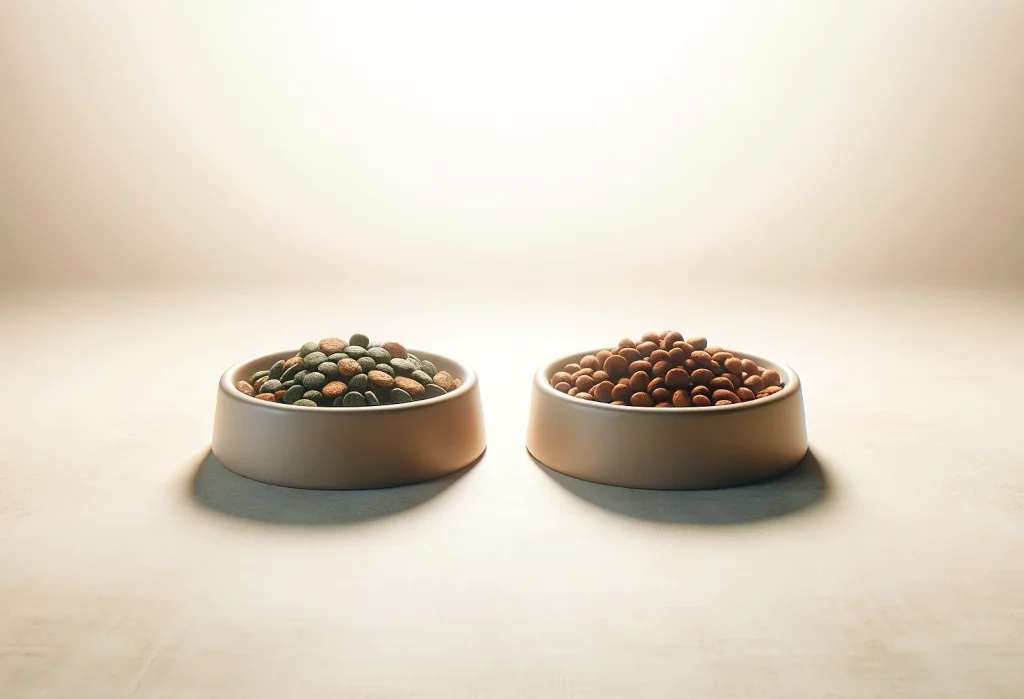Switching your dog to a new diet feels a bit like trying to teach an old dog new tricks—possible but peppered with a pinch of patience and persistence. It’s all fun and games until the bowl is pushed aside with a nose of disapproval.
In this blog post, you’ll learn how to seamlessly transition your furry friend to a new diet, ensuring both happiness and health.
Key takeaways:
- Identify clear reasons for diet change, focusing on your dog’s health and age-related needs.
- Transition to new food gradually, starting with a mix of 75% old food and 25% new, adjusting over time.
- Monitor your dog’s health and behavior closely, adjusting as necessary and consulting a vet for persistent issues.
Why Change Your Dog’s Diet?
Changing your dog’s diet isn’t a decision to be made on a whim, but there are plenty of solid reasons you might be considering the leap.
Maybe you’ve noticed your furry friend isn’t quite as spry as they used to be, or perhaps their coat isn’t shining quite as bright. Age can certainly be a factor; as dogs grow, their nutritional needs shift. Then there are health issues – a diagnosis might require a diet overhaul to ensure your pooch is getting the right nutrients without exacerbating any conditions. And let’s not forget about personal preferences.
More and more pet owners are moving towards organic, grain-free, or diet-specific foods based on emerging research and trends. Whatever your reason, understanding the ‘why’ behind the switch can make the ‘how’ a little less daunting.
What Can You Expect During the Transition?
Here’s the scoop: switch up your dog’s diet, and you’re bound to see some changes. It’s not all going to be smooth sailing, but knowing what to expect can help you both navigate these waters a bit more easily.
First off, don’t be surprised if your dog’s digestive system takes a bit of a hit. We’re talking potential diarrhea or constipation, maybe some gas. This is normal but keeping an eye on these symptoms is crucial; they should settle down after a while.
Then, there’s the energy levels. Your dog might be more lethargic than usual or the opposite, bouncing off the walls. This should also even out after their body adjusts to the new diet. An important bit you won’t find on the back of the dog food bag: your dog’s individual reaction is your best guide here. If they’re not adjusting well after a reasonable period, it might not be the right food for them. Each dog is unique, and there’s no one-size-fits-all when it comes to diet.
How to Introduce The New Diet Successfully?
Alright, you’re all in. So, how do we make this transition as smooth as peanut butter? Here’s a step-by-step playbook:
-
Start Slow : Think of this as a marathon, not a sprint. Begin by mixing a small amount of the new food with the old. A good ratio to start with is 25% new food to 75% old food. Keep this up for a few days.
-
Gradually Increase : Over the next week or so, slowly increase the proportion of new food while decreasing the old. Move to a 50/50 mix, then 75/25 in favor of the new food.
-
Monitor Closely : Keep a close eye on your dog’s reaction to the new diet. This isn’t just about watching for digestive issues; keep an eye on their coat, energy levels, and overall demeanor.
-
Be Consistent : Try to feed them at the same times every day. Consistency is key in helping your dog’s digestive system adjust.
-
Don’t Forget Water : Ensure your dog has constant access to fresh water. A diet change can lead to dehydration if they’re not drinking enough.
But here’s a pro tip that’s often overlooked: Consider the season. Changing your dog’s diet during a more stable, stress-free time of the year can make a big difference. For example, transitioning in the middle of summer when you’re home more often and can monitor their adjustment period, or perhaps avoiding high-stress periods like the holidays.
Remember, every dog reacts differently, so patience is key. By following these steps and staying alert to your dog’s needs, you’re setting the stage for a successful diet transition. Your pooch’s health and happiness are worth the effort, and trust me, they’ll thank you for it – in their own tail-wagging, face-licking way.
What If Your Dog Resists the New Diet?
Ah, the perennial challenge: you’re excited about introducing a healthier diet to your four-legged best friend, but they’re giving you the cold shoulder—or, shall we say, the cold snout? Don’t fret! Here’s the scoop on making this transition easier, even if your furry companion is the finickiest of eaters.
First off, patience is key. Change isn’t always easy, especially with taste buds on the line. If your dog turns up their nose at their new chow, consider these tricks:
-
Warm it up : Just like us, dogs can be more enticed by the smell and taste of warm food. Think about it — a warm meal often smells more appetizing and can make the food flavors more pronounced.
-
Broth is your friend : Adding a little sodium-free chicken or beef broth can make their new diet irresistible. The smell and taste of broth could transform an unappealing meal into a tantalizing treat.
-
Mix it up : Incorporating a small amount of wet food with their dry food (if their diet allows) can add a new texture and flavor that might just win over your picky eater.
Here’s the kicker that many might not tell you: dogs love consistency but also crave variety within that consistency. It sounds like a paradox, but hear me out. While transitioning to a new diet, keep the feeding schedule consistent but vary the flavors (within the new diet parameters) from meal to meal. This can encourage a sense of routine while keeping their taste buds enthused.
How to Monitor Your Dog’s Health During the Transition
Switching your dog’s diet isn’t just about convincing them to eat something new — it’s about ensuring the diet supports their health and well-being. Here’s what to keep your eyes peeled for:
Signs of a Successful Transition include:
-
Lively energy levels : Your dog doesn’t skip a beat and is as playful and energetic as ever.
-
Healthy poops : Yes, we’re going there. Their stool should be firm, small, and less smelly — a sign of good digestive health.
-
Shiny coat : A high-quality diet will make your dog’s coat glossy and healthy.
On the flip side, Red Flags might call for a pause or a vet visit:
-
Persistent diarrhea or vomiting : Occasional stress or dietary adjustments might cause a brief upset, but if it persists, it could indicate the diet isn’t right for your pup.
-
Lethargy : A noticeable drop in energy levels could mean your dog isn’t getting the nutrients they need.
-
Skin issues or dull fur : This could suggest the diet isn’t meeting all their nutritional needs.
Unique tip : Start a diet diary. Yes, it might seem over the top, but tracking what they eat, their behavior, and any physical changes (good or bad) can offer invaluable insights. This diary can be a goldmine of information for your vet if issues arise and ensures nothing gets overlooked.
Transitioning your dog to a new diet can be a smooth process with a little patience, observation, and creativity. Remember, every dog is unique, so what works for one may not work for another. Keeping a keen eye on their health and behavior during this period is crucial. With these tips and a positive approach, your dog will be thriving on their new diet in no time, and you’ll be the proud pet parent of a happy, healthy pup. Cheers to beginning this tasty and nutritious journey with your furry friend!
Alex, a passionate animal lover, has experience in training and understanding animal behavior. As a proud pet parent to two dogs and three cats, he founded AnimalReport.net to share insights from animal experts and expand his knowledge of the animal kingdom.





